KAMBERG GEM
The bee-you-tee-ful charcuterie of Franco Esposito
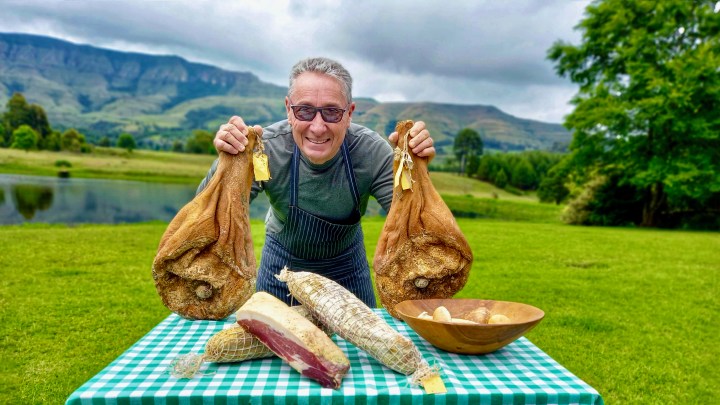
Franco Esposito makes charcuterie from the Kamberg. Prosciutto. Pancetta. Culatello. Cotechino. Being a farmer-charcutier is the same as being a photographer, what he did before, takes passion, creativity, commitment, time. Then there is that secret sauce.
Come. Stand inside here for a moment and smell. The aroma. Isn’t that beautiful? The man uttering these words, Franco Esposito, Kamberg charcutier, says “beautiful” a lot. Except how he says it, “bee-you-tee-ful” – accentuated, weighted, the Italian inflection? – makes it sound a lot more bee-you-tee-ful than when you say it or I say it.
The “here”, as in where we are standing to appreciate this particular bee-you-tee-ful experience, one of many I will be encouraged to wake up to over the next three or four days, is the cool interior of a walk-in cold room. Where a couple of dozen labelled and dated prosciutto hams hang, quietly and slowly ageing. Near a couple of dozen string-bound coppa hams, which dangle from metal hooks in their assigned spot.
The prosciutto and coppa are among the dozen-plus artisanal products Esposito makes, mainly from the pigs (12 right now) he grows on his farm and on the dairy farm (currently another eight) of his friend and neighbour, Brett Moller.
Esposito buys the piglets from a farmer at Verkykerskop, high up at the top of Van Reenen near Harrismith. “He does the pigs that I want. He breeds them nicely. They’re in pig-sties and he doesn’t use farrow crates.” They’re the (usually metal) devices commercial breeders use to restrict the sow so she cannot move.
“He has Duroc boars. It is a dark pig with phenomenally beautiful configuration in the hind quarters, which he crosses with either Landrace sows or large whites. He (the farmer) introduced me to a friend of his from Winterton (in the foothills of the Drakensberg) who does the same kind of thing, so I buy from him as well. I bring them to my place or Brett Moller’s.” Where they live outdoors. No growth hormones. No antibiotics. He will not call them free range because, he says, they are “corralled”. But within their large enclosures – and in one of the most pristine and tranquil settings I’ve had the pleasure of savouring in a long time – they furrow and forage. The ones on his farm, near a barn about a three minute stroll from the back door. He feeds his pigs milk and whey, and acorns in season, during their six-month life span. Before he takes them to the Boston Abattoir which, after trying several in the area, is the one he has settled on because he likes how they do things.
And I will share descriptions of what he calls his “product” for those of you, who like me, use the terms charcuterie and salumi loosely but don’t truly know the difference between the ass (which we’ll get to) and the elbow.
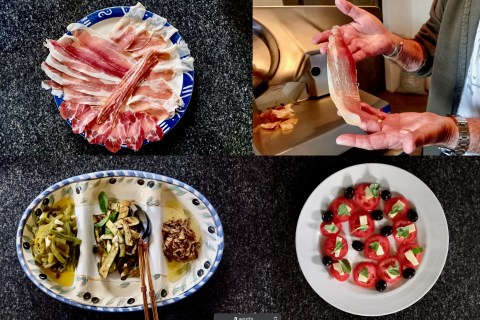
For lunch a charcuterie platter sliced with care; green peppers, courgettes and brinjals scorched, grilled, drizzled with olive oil; and a tomato salad with basil grown on the kitchen window ledge. (Photo: Wanda Hennig)
More about the prosciutto later as that is a story in itself. Just to say now, some of his have been ageing for two years and prosciutto is one of the cuts he slices wafer-thin to go onto our lunch plate the day I arrive. Cut with focus and the word that comes to mind, seeing the expertise and care: respect. Which I get a sense of is for the animal, the time involved, the tradition of it all. Using the slicer set on the metal table outside the walk-in where he has me pay attention to the aroma.
So there is his coppa, “the neck muscle, and it’s “bee-you-tee-ful”. True. I can vouch as this, too, is sliced for our platter.
“I make bacon. From the back, the loin, but I do a bacon that’s not just back bacon, it’s got a little bit of streaky as well. My bacon is smoked and has four ingredients: salt, sugar, juniper berries and mustard seeds, crushed. And it’s done in a dry cure. I don’t inject brine and that kind of crap. When you cook our bacon you don’t have any white stuff coming out and you also don’t lose 30 percent of the weight.”
He uses the belly for making his pancetta. And yes, we get that for lunch too.
“I make a variety of sausages.” Here, bush pig comes into the conversation. “They’re a real menace to agriculture around here because they’re super-destructive.” He shares a link to this Perennial Plate video you might like to watch where Esposito talks about bush pigs, their bee-you-tee-ful red meat, lack of natural predators and what he considers sustainable practices.
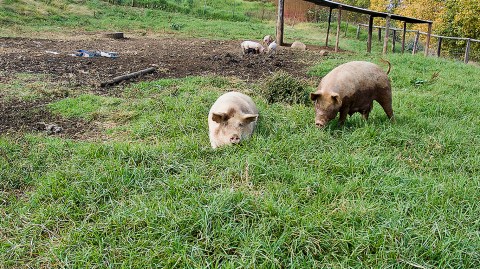
This is a pig’s life in Kamberg after the piglets are brought in as weaners. (Photo: Supplied)
“I make chorizo (seasoned pork sausage often associated with Spanish and Mexican cuisine). I just grind up all the meat from the rest of the animal. Mainly the shoulders and the trimmings; all the meat that gets left. When you separate the ribs from the belly and from the loin, there’s always meat hanging around and you just scrape it off. And from around the shoulders where you take the coppa…”
He makes guanciale out of the cheeks, the name derived from guancia, the Italian word for cheek.
He also makes culatello, and googling I find this fun read telling me, This ‘Little Ass’ is the Unsung Queen of Italian Cured Meats. It is also on our lunch plate. Yum. “So culatello is prosciutto cured off the bone,” he explains. “What you do is you take the exterior part, the bum, and you separate that from the bone. You shape it, you put it into casings, you cure it and then you let it hang. And that’s it.”
“I make speck sometimes, also the leg,” he adds. Which, like his bacon, is smoked. “Our smoker is fairly rudimentary (drums, metal rods, pipes, a burner) but it works like a charm.”
Oh! Excitement as he remembers: “I also make cotechino and it’s a very interesting thing. It’s a sausage, quite large, the spicing is very different. Also part of an Italian tradition. People were asking for bacon with rind so I just made a batch with rind but usually, it’s without rind and you use that rind in the cotechino. You cut it up small when it’s very fresh, otherwise it hardens; and you mince that with the meat and the spice. It takes about three hours to cook and traditionally you serve it with lentils for New Year’s Eve. The thing is, lentils represent wealth. So if you eat lots of lentils on New Year you’ll have a fantabulously wealthy new year. But we do it because we really like the cotechino.” Right.
And now he also remembers: “Bresaola, that’s the only beef thing I do. It’s cured beef. I buy it, grass-fed beef, from Linga Lapa. It’s the eye of silverside and looks very much like a coppa, except it’s a lot leaner.
“Oh, and I make brawn as well.” Cold-cut terrine set in aspic, which I grew up eating because my Polish dad loved it and would bring it home. So clearly it is not specifically an Italian thing. And to Google brawn, a.k.a. head cheese, is to learn that just about every country, including South Africa, has a version.
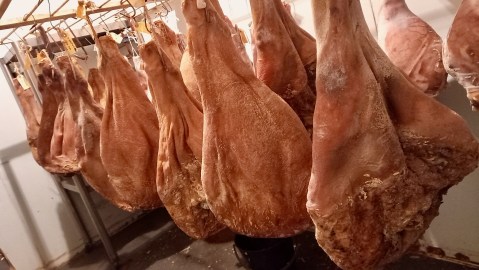
Quietly and slowly ageing in the walk-in, these carefully prepared prosciutto hams. (Photo: Wanda Hennig)
Back to what I’m being told to smell. The aroma drifting from the contents of a large rectangular container on the floor. Filled with what in the dull interior light looks like cubed chunks of meat. Esposito is talking about hot flames to scorch capsicums, as in red and yellow and green bell peppers. Putting them in brown paper bags, which makes them easy to peel. De-seeding them and slicing them.
And then there’s the garlic and hot paprika and smoked paprika and wine and chillies. All this is mixed around a couple of times a day by assistants, Thulani Khanyile and Mavis Zuma, so the fresh flavours penetrate, infuse, the equal parts of pork meat and fat. And yes, the aroma is kind of heady and rich and sweetish and subtly pervasive.
“I’m making spreadable salami,” Esposito explains. Nduja, I will learn later when I ask him to tell me the story all over again so I can turn on my little recorder to get the details. “It’s funny because ‘j’ is not part of the Italian alphabet.” But yes, it is an Italian word and nduja is traditionally from Calabria, “the part of Italy right at the bottom. The boot. Across the Strait of Messina to Sicily on the other side”. It is only his second batch of nduja. “I’ll put it all through the mincer twice.” Then into the natural casings. “I was experimenting. I made 20 kilos of it and it’s gone. I sold the last one at the market the other day to someone who had bought it before, who came in and said, I want those, and took them. It seems to be quite popular so I’m making another 20 kilos.”
The walk-in is one of two, in separate rooms off the metal-gated double garage in the production facility near, but set a little way from, the farmhouse on the farm in the Kamberg he bought in 1996 with the idea that at some stage he and his wife, Debbie, would move here and live here. Give up their spread in Saxonwold, from where he operated for 20-plus years as a high-flying high-end commercial photographer.
They made the move a couple of years earlier than planned after “things started changing radically in the advertising industry from the year 2000. I started to get fed up”. And one day, said to Debbie, “Bugger it, let’s go and do something else. And charcuterie came to mind because I always liked charcuterie.
“So basically what actually happened, I went and met, through a friend of my mother’s, this fellow in the Apennines just outside Rome. His name was Francesca. My namesake. He was a helluva character. He was an ambulant charcutier (ambulant, as the name implies, being someone who moves from place to place), although there is another name. He called himself a norcino (pork butcher), a derivative of a place in Umbria called Norcia, which is where the first Italian charcuterie came from.”
A brief aside at this point, to talk about provenance, pigs and porcini. In my recording, I ask him to tell me about the porcini mushrooms making aroma-invoking splishing sounds as he sizzles them in olive oil.
Provenance, like beautiful, is a word that comes up often in conversation with Esposito. Food provenance, as in knowing where something was grown, caught or raised. Knowing how the food was produced and transported. The soil, the environment, the climate, the farming methods; all things that influence the product and give it its unique characteristics and taste.
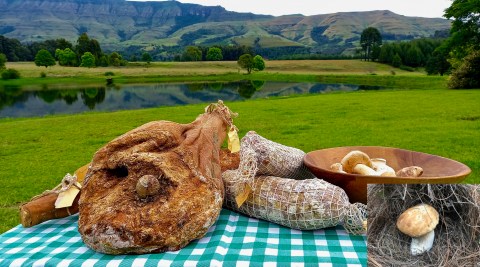
Provenance, porcini (inset and in the bowl) and pigs. Nature’s bounty at Esposito’s Kamberg farm. (Photo: Wanda Hennig)
Look at the picture above, taken just off the farm’s front porch with the farm dam and the view across to the mountains that appeared in sunshine, disappeared into mist and drizzle, changed with the light, all the time I was there. See the porcini mushrooms alongside the gifts from the pigs. Product and provenance. When I read about Norcia, “Italy’s capital of pork”, while writing this story, I see the Umbrian town is home to the finest artisanal butchers in Italy and some of the “happiest, most looked-after pigs” that eat acorns from the forests, which have an abundance of wild boar. They have truffles there. Esposito’s farm regularly surprises him with porcini mushrooms. Africa. Italy. Me, being romantic, noting similarities between Norcia and where he is set up in the Kamberg?
“These porcini are incredible,” says Esposito. “I just go into the forest and it’s this gift from nature. You know, you just go there, and suddenly out of the blue, there is this offering. They come after rain and thunder and you can’t cultivate them. The spores are in the roots of the trees, very much like truffles, and basically what you need is thunder and lightning, the forest bed to get quite moist. And then you need a lot of sun. And when the sun comes out, then the porcini sprout. So I don’t need to do anything except just wait. Mother Nature just gives them to us.”
Back to namesake Francesca: it transpires that where they were in Italy, there are co-ops where smaller delis take their pork cuts to be cured. “All you need for the curing is to have the right temperature and the right humidity. And the whole thing about curing is time. If you cure too quickly, you don’t give time for the flavours to develop.”
Francesca would go prepare the cuts at the shops and delis for the owners to take to have cured. “He would process their pigs. Then the shop owner would rent space at the co-op where the meat would cure over time.
“And this guy was phenomenal. Strange and quirky. So many good stories to tell.
“How it worked, Debbie and I had to meet him at 6am, which was two hours before the shop opened. He would cut up the pigs, get the hams, get the coppa, get the sausages prepared over three or four days and when it was done, move on to the next place.
“So anyway, on the first day we arrived there at 6 o’clock. He supplied us with aprons. And we started working with him. Debbie taking notes and photographs. I was talking to him, asking questions, and he was very free with imparting his knowledge.
“Eventually 8 o’clock comes. We’re in the cellar down beneath the shop. He shouts upstairs to the people in the shop that he wants breakfast. And down comes this woman and she’s got three beautiful big crusty rolls (he indicates with two hands, huge). And brawn to eat with the rolls. And I could not believe this, but she brings a half-litre tankard of white wine for the guy. And a carafe of wine for us. At 8 o’clock in the morning.
“That was his routine every day. Then he would keep working. Stop briefly for lunch. Then about four in the afternoon he’d go home. Then back to the shop the next morning. We did that with him for a couple of months.” And so began the career that brings us to where he is, here and now.
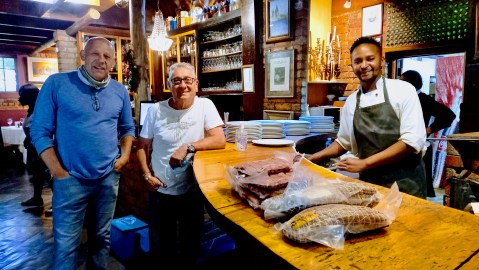
Franco Esposito, centre, makes a delivery to Pino Canderle, left, owner-chef at La Lampara Italian restaurant and chef, Bayanda Hlela. (Photo: Wanda Hennig)
Esposito was born near Turin, Italy, in a refugee camp where his dad worked after WWII for the International Refugee Organisation, which was repatriating mainly Polish Jews and other displaced Poles. “My first cot was made for me by a Polish carpenter,” he shares, aware of my Polish roots and interest.
Subsequent to that “we moved to all manner of different countries.” His dad worked briefly for NATO and then, until he retired, for the Food and Agricultural Organisation of the UN. “So we were in the Congo. In Tanzania. In Kenya, where I did my A levels. Then I took a sabbatical. I wanted to travel.”
In 1969 he arrived with a friend in Durban on (the passenger liner) Pendennis Castle. “I stepped off the ship and to me that was the best step I’ve ever taken in my life. Durban seduced me immediately. It was just wonderful. I loved it.”
It was also where he would meet his wife, Debbie, although he didn’t know that at the time.
“So anyway, I went to Natal University (now the University of KwaZulu-Natal).” Started off doing an economics degree. Switched after a year to a BA. Majored in politics and economic history. “I feel ashamed to admit it took me four years to get a BA but then I had 13 credits instead of 10, so I don’t feel that bad.”
Then, in May 1974, he went to England to become an apprentice photographer to a fellow working for the legendary Terence Conran, founder of the Design Museum in London (among many things). “I went to England and I wanted to become a photographer and I became a photographer. And an interesting thing…” Seeing we’re talking food, this memory comes back.
“Conran had a big house, it was formerly a school in a place called Newberry (in Berkshire). And it was actually quite incredible. We would do a catalogue every year. And during the shooting of the catalogue, we would go for four days a week, to Newberry.”
Conran had by then married his third wife, Caroline (Herbert) Conran. “She was a food writer who had a column in Vogue. There I was earning seriously very little money, I think £7 pounds a week, but I was fed at lunchtime and on Monday night, Tuesday night, Wednesday night by Caroline Conran, eating all this really lovely food.”
He came back to South Africa as a photographer. By then married to Debbie. Opened a studio at the Barbican Building in Johannesburg. Was offered the position of house photographer at what would become the award-winning ad agency, Ogilvy. Went on his own after a couple of years there. International awards, campaigns, recognition. Plate cameras: Hasselblads, Mamiyas. Film. Then enter the digital age. He recapitalised. Got the Macs. Did what it took from his side. But became fed up as the level of professionalism and expectations changed.
While living and working in Johannesburg, he and Debbie often stopped at the Kamberg Nature Reserve so he could fly-fish while on their annual trip to the coast. “That’s just around the corner. You’ve been there. Seen the Bushman paintings.”
It was on such a visit that he found his farm, along the road to the Highmoor Nature Reserve in the section of the Drakensberg that is a World Heritage Site. It coincided with Esposito being fed-up that the former owner, who had agreed to stay on and look after the place after the sale went through, wanted to move two years earlier than anticipated.
“So we came to the farm and I started putting things into motion. I bought a little bit of equipment and started making things. I remember that my first sortie with my prosciutto was at a wake for friends in the valley. We were all asked to bring something and I sliced this prosciutto, which turned out to be just very nice.”
And that was the start. Now his product goes to top restaurants around the Midlands. Hartford House. Jackie Cameron at her School of Food & Wine in Hilton, who he credits with initially putting him on the map. La Lampara, where I go with him to make a delivery and hear him tell owner-chef Pino Canderle about the veal he has just started supplying to an Italian outlet in Johannesburg.
“It’s quite a contentious conversation because there are all sorts of views on veal,” he says later, explaining – for those who have heard weird stories – that, basically, veal is made from very young animals that are milk-fed to the point of slaughter. “So you have this situation where a dairy herd only works when the cows are pregnant. When they lactate. They’ve got to be pregnant all the time. When a dairy cow has a bull calf, that bull calf is no good to the dairy herd.”
It is these bull calves that can be used for veal. “Proper veal will not have eaten any grass. Three months is our ceiling. It starts becoming uneconomical after that. And yes, this is new. We did one, as a trial. The same person has now ordered another three. He liked it very much. I had a taste of it myself. It was very good. I made osso buco out of the shin.”
Many top Italian delis and outlets in Johannesburg buy from him. And you’ll find him any Saturday morning slicing and selling at Nottingham Road’s Earth Route farmers market.
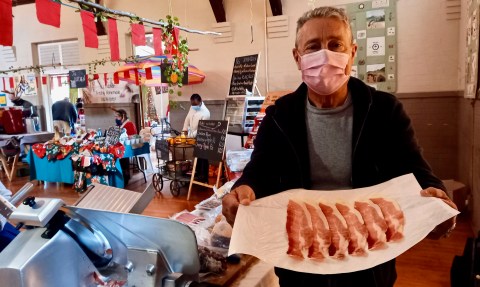
Saturday mornings see Esposito slicing and selling at Nottingham Road’s Earth Route farmers market. (Photo: Wanda Hennig)
So when Esposito went to do his early grass-roots training with Francesco in Italy, what he most wanted to learn about was prosciutto. “That’s the apex,” he says. “The very well known prosciutto from Italy is Parma ham. So if it is made in Parma, you’re allowed to call Parma ham. It’s an appellation d’origine contrôlée thing, like Champagne and Chianti. This, that I make, is prosciutto from the Kamberg.
“And you know, I can tell you, those that come out of Parma are not necessarily the best.”
The best he has ever eaten was, he says, at a place called Eataly in Rome. Eataly, the chain of Italian marketplaces founded by Oscar Farinetti, an entrepreneur formerly involved in consumer electronics who collaborates with Slow Food. For those travelling to the UK any time soon, check out this link to the newest Eataly, described as a cathedral of slow food and fine wine, which opened in London in 2021.
“The guy in Rome was very kind to let me taste a little sliver of pata negra. That is a prosciutto made in Spain from wild foraging pigs. To me, this is right up there. The best I ever tasted. I get fed up sometimes, people just want to make things precious. I’ve never been one that takes people’s words as sacrosanct. I’ve got to taste it then make up my mind. Having said that, I don’t say I make the best. I think I make good stuff and I make it properly.”
This story happened the week before Christmas. About six months after I first asked Esposito if I might visit and write about him some time. He wasn’t easy to pin down. He came up with suggestions for so many other people and places I might write about, I began to wonder if he was trying to fob me off.
But no. He is just one of those generous-of-spirit enthusiastic mensch-type guys who likes to share and give credit and who lives with commitment and passion. And then there is that secret sauce. “Basking in the praise.” His words. “Sometimes if people come to me and say, ‘That was really nice’, to me that is almost better than the money I get out of it. You know, it’s truly gratifying.” May he long bask in the praise so we may relish the provenance and the prosciutto. DM/TGIFood
Visit Esposito Foods: Charcuterie from The Kamberg on Facebook and on Instagram and see his Esposito photo site.
The author supports Food Forward SA, committed to a South Africa without hunger. Please support them here.




 Become an Insider
Become an Insider
I want to visit.